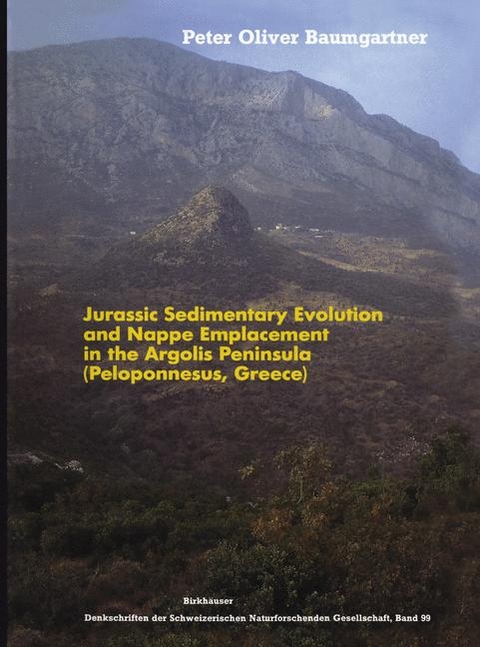
Jurassic Sedimentary Evolution and Nappe Emplacement in the Argolis Peninsula (Peloponnesus, Greece)
Springer Basel (Verlag)
978-3-0348-9994-9 (ISBN)
- Titel wird leider nicht erscheinen
- Artikel merken
Abstract.- Résumé.- Zusammenfassung.- A. Introduction.- 1 Geological Frame, Definition of Units and Main Results.- 1.1 Adhami Composite Unit.- 1.2 Dhidhimi — Trapezona Composite Unit.- 1.3 Akros Unit and Emplacement of Eocene Units.- 2 History of Research.- 3 Objectives of Study and Methods of Investigation.- Methods of Investigation.- B. Sedimentary Stratigraphy and Paleogeographic Evolution.- 1 Basal Sequences.- 1.1 From Shallow Water to Pelagic Sedimentation — Evolution of a Passive Continental Margin.- 1.1.1 Pantokrator Limestone — Late Triassic and Early Jurassic Shallow Water Limestones and Dolomites.- Name and Occurrence.- Lithology and Age.- Conclusive Remarks on the Facies Evolution of the Pantokrator Limestone.- 1.1.2 Pelagic Limestones and Rosso Ammonitico.- Sequence 1.- Sequence 2.- Sequence 3.- Sequence 4.- Paleogeographic Evolution.- 1.1.3 Ayios Nikolaos Chert.- 1.1.4 Angelokastron Chert.- 1.2 Classic Deposition and Formation of Olistostromes — Evolution of an Active Continental Margin.- 1.2.1 Kandhia Breccia.- Short Definition.- Type Section.- Composition and Lateral Variation.- Sedimentology.- Environment of Deposition.- Origin of Clasts.- 1.2.2 Dhimaina Formation.- Short Definition.- Previous Work.- Type Sections.- Dhimaina Formation Lower Member.- Sedimentology and Depositional Setting of the Lower Member.- Dhimaina Formation Upper Member.- Sedimentology and Depositional Setting of the Upper Member.- Lateral Variation.- 1.2.3 Potami Formation.- Short Definition.- Previous Work.- General Occurrence and Distinction from Other Formations.- Type Area.- Lithologies.- Age of the Potami Formation.- Origin of Clasts.- Mode of Debris Emplacement and Accumulation.- Contact with the Overlying Migdhalitsa Ophiolite Unit.- 2. Overlying Late Jurassic Nappes.- 2.1 Asklipion Unit.- 2.1.1 Theokafta Subunit.- Occurrence.- 2.1.1.1 Adhami Limestone.- 2.1.1.2 Koliali Chert.- Occurrence.- Lithology.- Age.- 2.1.1.3 Olistoliths of Anisian to Norian.- Asklipion Limestone.- Occurrence.- Bio- and Lithostratigraphy.- 2.1.1.4 Sedimentologic and Paleogeographic.- Conclusions on the Theokafta Subunit.- 2.1.2 Main Asklipion Unit.- Occurrence.- 2.1.2.1 Early to Middle Triassic Acidic.- Volcanics and Tuffs..- Occurrence.- Age…..- 2.1.2.2 Ayios Andreas Beds.- Occurrence.- Age.- Sedimentology.- 2.1.2.3 Adhami Limestone.- Occurrence.- Age.- Sedimentology.- 2.1.2.4 Transition to the Koliaki Chert.- Generalized Stratigraphy, Ages and Sedimentology.- Sedimentologic and Paleogeographic Interpretation.- 2.1.2.5 Koliaki Chert.- Occurrence.- Facies Development.- Age.- 2.1.2.6 Clastic Formations.- Facies Development.- Age.- 2.2 Ophiolites.- 2.2.1 Introduction.- 2.2.2 Occurrence of Ophiolite Lithogies in Several Structural Positions.- 2.2.3 Migdhalitsa Ophiolite Unit.- C. Petrography and Geochemistry of Ophiolites, Ophiolite Clasts and Triassic Volcanics.- 1. Petrographic Remarks on the Ophiolites.- 1.1 Mafic and Ultamafic Cumulates.- 1.1.1 Serpentinized Dunites and Harzburgites….- 1.1.2 Pyroxenites.- 1.1.3 Gabbros.- 1.1.4 Conclusive Remarks on the Cumulates.- 1.2 Mafic Volcanic Rocks.- 1.2.1 Dolerites.- 1.2.2 Basaltic (Pillow-) Lavas.- 2. Geochemistry of Ophiolites and Triassic Acidic Volcanics.- 2.1 Introduction.- 2.2 Methods of Analysis and Presentation of Data.- 2.3 Graphic Representation of Data and Discussion of Results.- 2.3.1 AFM and Ka-K-Ca Ternary Diagrams.- 2.3.2 Discriminant Analysis after Pearce (1976).- 2.3.3 Trace Elements: Ti-Cr and Ti-Zr Diagrams.- 3. Conclusions.- D. Chrome Spinel and Clay Mineralogy.- 1 Chrome Spinel Mineralogy.- 1.1 Introduction.- 1.2 Optical Indentification and Extraction from Clastic Rocks.- 1.3 X-Ray Energy-Dispersive Analysis.- Main Results.- Compositional Trends.- 1.4 Conclusions and Geological Significance.- 2 Clay Mineralogy.- 2.1 Introduction.- 2.2 Results.- 2.3 Conclusions and Geological Significance.- E. Conclusions.- 1 General Evolution, Palinspastic Position and Late Jurassic Emplacement of Units.- 1.1 Basal Sequences.- 1.2 Asklipion Unit.- 1.3 Migdhalitsa Ophiolite Unit.- F. Acknowledgments.- G. References.
| Erscheinungsdatum | 20.12.2018 |
|---|---|
| Zusatzinfo | 111 p. 43 illus. |
| Verlagsort | Basel |
| Sprache | englisch |
| Maße | 230 x 310 mm |
| Themenwelt | Sachbuch/Ratgeber ► Natur / Technik |
| Naturwissenschaften ► Geowissenschaften ► Geologie | |
| Schlagworte | Calculus • Evolution • Geochemistry • Jura • mesozoisch • Trias • Vulkanit |
| ISBN-10 | 3-0348-9994-7 / 3034899947 |
| ISBN-13 | 978-3-0348-9994-9 / 9783034899949 |
| Zustand | Neuware |
| Haben Sie eine Frage zum Produkt? |
aus dem Bereich


